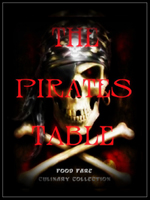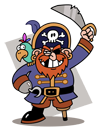![]()
Characteristics commonly associated with a stereotypical pirate include rotten or missing teeth, beards, bicorn hats, cutlasses (swords), earrings, eye-patches, hooks for hands, Jolly Roger symbols and flags (skull & crossbones), long and colorful head scarves, Navy jackets, parrots, peg-legs and tall black boots.
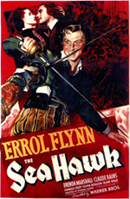 Pirates have also been popularized in films, some of which include
The
Sea Hawk (1940, starring Errol Flynn); The Black Swan (1942, starring
Tyrone Power); Anne of the Indies (1951, starring Jean Peters);
Blackbeard the Pirate (1952, starring Robert Newton); A High Wind in
Jamaica (1965, starring Anthony Quinn); Blackbeard's Ghost (1968,
starring Peter Ustinov); Treasure Island (1972, starring Orson Welles);
Swashbuckler (1976, starring Robert Shaw); The Island (1980, starring
Michael Caine); Nate & Hayes (1983, starring Tommy Lee Jones);
Treasure
Island (1990, starring Charlton Heston); Hook (1991, starring Dustin
Hoffman); among many others.
Pirates have also been popularized in films, some of which include
The
Sea Hawk (1940, starring Errol Flynn); The Black Swan (1942, starring
Tyrone Power); Anne of the Indies (1951, starring Jean Peters);
Blackbeard the Pirate (1952, starring Robert Newton); A High Wind in
Jamaica (1965, starring Anthony Quinn); Blackbeard's Ghost (1968,
starring Peter Ustinov); Treasure Island (1972, starring Orson Welles);
Swashbuckler (1976, starring Robert Shaw); The Island (1980, starring
Michael Caine); Nate & Hayes (1983, starring Tommy Lee Jones);
Treasure
Island (1990, starring Charlton Heston); Hook (1991, starring Dustin
Hoffman); among many others.
Perhaps the most well-known pirate movies are films in the "Pirates of the Caribbean" series starring Johnny Depp (The Curse of the Black Pearl, Dead Man's Chest, At World's End, On Stranger Tides and Dead Men Tell No Tales). Reportedly, a sixth film in the series is scheduled for a reboot in 2024.
Learn about famous pirates through history.
-
Samuel Bellamy (aka Black Bellamy, Black Sam or Prince of Pirates; 1689-1717). Bellamy was born in England, where his mother died shortly after giving birth to him. He travelled to Cape Code, Massachusetts at a young age. Bellamy went on to become a crew member of the Mary Anne, which was commanded by Captain Benjamin Hornigold (whose first mate was Edward "Blackbeard" Teach). After Hornigold was disposed as captain in 1716, remaining crew members elected Bellamy as their new leader. Later, Bellamy also captained the Sultana and the galley ship Whydah Gally. Bellamy was known to be merciful to those he captured during raids. Just two months after acquiring Whydah Gally in 1717, Bellamy was killed during a violent storm off the coast of Cape Cod. In 1984, the wreckage of Whydah Gally was discovered. The ship’s hold contained large quantities of gold, indigo, ivory and pound sterling, which marked Bellamy’s place in history as the wealthiest pirate.
-
Stede Bonnet (aka The Gentleman Pirate; 1688-1718). Bonnet was born into a wealthy family on Barbados, where he inherited the family estate in 1694. However, by 1717 Bonnet had turned to piracy. His ship Revenge lurked along the Eastern Seaboard (USA), where he captured or burned other sailing vessels. After being wounded during an encounter with a Spanish warship, Bonnet recuperated in Nassau, where he also met Edward "Blackbeard" Teach. During 1717, Bonnet and Blackbeard plundered ships together near Delaware Bay and in the Caribbean. The two pirates went their separate ways near the end of 1717, after which Bonnet tried to forsake a life of crime. It wasn’t until the summer of 1718 when Bonnet took up piracy again, at one point captaining Queen Anne's Revenge. He later took on the alias "Captain Thomas," changing the Revenge's name to Royal James. After a battle with Colonel William Rhett in Cape Fear River, Bonnet and his men surrendered. In November 1718, Bonnet was brought to trial in Charleston, South Carolina. He was sentenced to death, and hanged less than one month later.
-
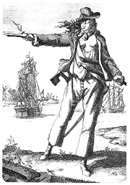 Anne
Bonny (aka Anney; 1702-1782). Bonny was born in
Ireland, but traveled to the New World at a young age. Her father
William Cormac became a successful merchant in South Carolina, where
he managed to accumulate a great deal of wealth. Red-headed and
fiery, Anne reportedly stabbed a servant girl when she was barely
thirteen years old. Anne married a little-known pirate named James
Bonny, after which she was disowned by her father. By 1718, the
couple had moved to Nassau, Bahamas, a known sanctuary for English
pirates at the time. James Bonny became an informant for the
governor. Meanwhile, Anne mingled with pirates on the island,
eventually befriending John (Calico Jack) Rackham. The two fell in
love, running away together to live as pirates. They joined forces
with Mary Read to steal the sloop Revenge, later capturing
other ships and scoring impressive treasures. In 1720, the threesome
was captured and brought to trial in Jamaica. Rackham was hanged,
but both Anne and Mary Read were spared after claiming to be
pregnant. There are historical disputes as to Anne's eventual fate.
Some claim she simply disappeared, while others insist she was
released from Jamaican prison thanks to her father's business
connections. The second account also claims she returned to South
Carolina, where she married a local man named Joseph Burleigh and
bore ten children. Anne Bonny allegedly lived to the ripe old age of
eighty-one, and was buried in York County, Virginia.
Anne
Bonny (aka Anney; 1702-1782). Bonny was born in
Ireland, but traveled to the New World at a young age. Her father
William Cormac became a successful merchant in South Carolina, where
he managed to accumulate a great deal of wealth. Red-headed and
fiery, Anne reportedly stabbed a servant girl when she was barely
thirteen years old. Anne married a little-known pirate named James
Bonny, after which she was disowned by her father. By 1718, the
couple had moved to Nassau, Bahamas, a known sanctuary for English
pirates at the time. James Bonny became an informant for the
governor. Meanwhile, Anne mingled with pirates on the island,
eventually befriending John (Calico Jack) Rackham. The two fell in
love, running away together to live as pirates. They joined forces
with Mary Read to steal the sloop Revenge, later capturing
other ships and scoring impressive treasures. In 1720, the threesome
was captured and brought to trial in Jamaica. Rackham was hanged,
but both Anne and Mary Read were spared after claiming to be
pregnant. There are historical disputes as to Anne's eventual fate.
Some claim she simply disappeared, while others insist she was
released from Jamaican prison thanks to her father's business
connections. The second account also claims she returned to South
Carolina, where she married a local man named Joseph Burleigh and
bore ten children. Anne Bonny allegedly lived to the ripe old age of
eighty-one, and was buried in York County, Virginia. -
Edward England (aka Edward Seegar; died 1720). Born in Ireland, Edward became active as a pirate in Jamaica as a mate aboard the Lark in 1718. A few years later, he joined forces with Oliver La Buse. They succeeded in capturing the vessel belonging to veteran Scottish seaman James Macrae. Because Edward spared the life of Macrae, his crew rebelled and voted to have him ousted as captain. Edward was marooned on Mauritius Island for a time, but eventually made his way to St. Augustine's Bay, Madagascar. He survived for a brief period through beggary, but died near the end of 1720.
-
Henry Every (aka Long Ben; 1659-1696). Devon-born Henry Every served in the Royal Navy from 1689 to 1690, after which he turned to slave-trading in Africa. Historians note Every traded under the protection of governors Cadwallader Jones (Bahamas) and Issac Richier (Bermuda) for two years. In 1693, Every was hired by King Charles II of Spain to follow French ships in the West Indies. When the Spanish king failed to pay the wages of Every and his crew, they mutinied. Every took over the royal sailing vessel, renaming it the Fancy, and went on to the African coast. In Maio, Every committed his first acts of piracy when he plundered three English merchant ships. In 1695, Every managed to capture the Grand Mughal vessels Ganj-i-sawai and Fateh Muhammed in the Arabian Sea. The ships gave over nearly £600,000 in treasure, rendering Every the richest pirate in the world. After large bounties were placed on their heads, Every and his crew fled to the Bahamas. However, Every eluded capture. Records of his existence vanished after 1696. Many historians believe he changed his name, and then lived out his life quietly in Britain or on an unknown tropical island.
-
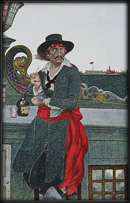 William
Kidd (aka Captain Kidd; 1645-1701). Born in
Scotland in 1645, the first historical mention of Captain Kidd did
not occur until 1689, when he was a crew member of a pirate ship
sailing off the Caribbean. Apparently, Kidd and the rest of the crew
mutinied and renamed their ship Blessed William. Later,
they joined a small fleet led to defend Nevis Island from the
French. Afterward, Kidd went on to New York City, where he married
wealthy socialite Sarah Bradley Cox Oort in 1691. It is believed
Kidd also helped build Trinity Church in New York. In 1695, Governor
Richard Coote (Earl of Bellomont) asked Captain Kidd to attack all
those associated with pirates. He was outfitted with the sailing
vessel Adventure Galley, and given letters of marque by
King William III of England. Upon arrival in the Cape of Good Hope
in 1696, several of Kidd’s crew members died of cholera and the
Adventure Galley developed several leaks. His seeming
reluctance to attack and capture pirates made the Royal Navy
suspicious, which led them to believe Kidd himself was a pirate. In
1698, Captain Kidd took the Armenian ship Quedagh Merchant,
which was full of muslins, satins and silks, as well as gold and
silver. He renamed the vessel Adventure Prize and sailed
for Madagascar, where most of his crew abandoned him for Captain
Robert Culliford of the Mocha Frigate. Returning to
America, Captain Kidd was arrested in Boston. He was later sent to
England for prosecution on charges of piracy and the murder of his
Adventure Galley crewman William Moore. He was hanged in
London on May 23, 1701.
William
Kidd (aka Captain Kidd; 1645-1701). Born in
Scotland in 1645, the first historical mention of Captain Kidd did
not occur until 1689, when he was a crew member of a pirate ship
sailing off the Caribbean. Apparently, Kidd and the rest of the crew
mutinied and renamed their ship Blessed William. Later,
they joined a small fleet led to defend Nevis Island from the
French. Afterward, Kidd went on to New York City, where he married
wealthy socialite Sarah Bradley Cox Oort in 1691. It is believed
Kidd also helped build Trinity Church in New York. In 1695, Governor
Richard Coote (Earl of Bellomont) asked Captain Kidd to attack all
those associated with pirates. He was outfitted with the sailing
vessel Adventure Galley, and given letters of marque by
King William III of England. Upon arrival in the Cape of Good Hope
in 1696, several of Kidd’s crew members died of cholera and the
Adventure Galley developed several leaks. His seeming
reluctance to attack and capture pirates made the Royal Navy
suspicious, which led them to believe Kidd himself was a pirate. In
1698, Captain Kidd took the Armenian ship Quedagh Merchant,
which was full of muslins, satins and silks, as well as gold and
silver. He renamed the vessel Adventure Prize and sailed
for Madagascar, where most of his crew abandoned him for Captain
Robert Culliford of the Mocha Frigate. Returning to
America, Captain Kidd was arrested in Boston. He was later sent to
England for prosecution on charges of piracy and the murder of his
Adventure Galley crewman William Moore. He was hanged in
London on May 23, 1701. -
Lady Killigrew (aka Elizabeth Trewinnard; 1525-1582). Born Elizabeth Trewinnard, Lady Killigrew was the oldest daughter of James and Phillipa Trewinnard of St. Erth, Cornwall. She married Sir John Killigrew, by whom she had ten children. Sir John controlled most of the shipping in the Arwenack (now Falmouth) area, where he and Elizabeth preyed on rich cargo ships. They also bribed harbormasters and other officials with large fees in order to keep their ventures quiet. After her husband died in 1567, Elizabeth went on with the illicit activities. Most historians believe she never took part in actual criminal raids, but she was arrested for receiving stolen goods in 1582. She was sentenced to death at trial, but later pardoned by Queen Elizabeth I.
-
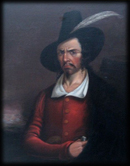 Jean
Laffite (aka Terror of the Gulf; 1776-1823).
Thought to be born in the French colony of Saint-Domingue in 1776,
Jean Lafitte and his family relocated to New Orleans sometime during
the 1780s. Jean and his older brother Pierre became privateers.
After the US government began enforcement of the Embargo Act
in 1808, the Laffite brothers continued their smuggling operation
from Barataria Bay in the Gulf of Mexico. Several years later, they
hired Captain Trey Cook to run a newly-purchased schooner ship.
Their first booty came from a Spanish brig, which they renamed
Dorada. Over time they also acquired more ships, including
La Diligent and Petit Milan. In 1812, Jean was charged
with violation of revenue law. He failed to appear at trial. General
Andrew Jackson accepted Lafitte's maritime assistance during combat
with the British in 1814, after which he was pardoned but barred
from Barataria Bay. Lafitte settled in the Spanish-occupied Texas
territory for a time, where both Jean and Pierre established a
pirate colony known as Campeche on Galveston Island. They were
eventually forced out of Galveston, yet not before burning down the
settlement. Jean Lafitte ended his days by pirating Central American
ports with his brother Pierre, until his death in 1823 in Yucatán.
Jean
Laffite (aka Terror of the Gulf; 1776-1823).
Thought to be born in the French colony of Saint-Domingue in 1776,
Jean Lafitte and his family relocated to New Orleans sometime during
the 1780s. Jean and his older brother Pierre became privateers.
After the US government began enforcement of the Embargo Act
in 1808, the Laffite brothers continued their smuggling operation
from Barataria Bay in the Gulf of Mexico. Several years later, they
hired Captain Trey Cook to run a newly-purchased schooner ship.
Their first booty came from a Spanish brig, which they renamed
Dorada. Over time they also acquired more ships, including
La Diligent and Petit Milan. In 1812, Jean was charged
with violation of revenue law. He failed to appear at trial. General
Andrew Jackson accepted Lafitte's maritime assistance during combat
with the British in 1814, after which he was pardoned but barred
from Barataria Bay. Lafitte settled in the Spanish-occupied Texas
territory for a time, where both Jean and Pierre established a
pirate colony known as Campeche on Galveston Island. They were
eventually forced out of Galveston, yet not before burning down the
settlement. Jean Lafitte ended his days by pirating Central American
ports with his brother Pierre, until his death in 1823 in Yucatán. -
Edward Lowe (aka Ned Lowe; 1690–1724). Ned Lowe was born into extreme poverty in Westminster, London, taking to common thievery at an early age. Later, he migrated to Boston, Massachusetts, where his wife died in childbirth in 1719. Two years later Lowe became a pirate, working the Azores and regions of the Caribbean and New England. He was known to have captured more than one hundred ships, burning most of them in the process. Some of the ships under his command included Ranger, Rebecca, Rose Pink and Merry Christmas. Lowe was also known to be one of the most vicious pirates in history, seeming to enjoy brutal torture before killing his victims. Various historical accounts claim he burned a French cook alive, saying he was a "greasy fellow who would fry well." Other forms of brutality entailed "mutilations, disembowelings, decapitations and slaughter." While there are varying claims about the true nature of Lowe's eventual death, author Charles Ellms (The Pirates Own Book Authentic Narratives of the Most Celebrated Sea Robbers, 1837) suggests Lowe was set adrift by the crew of the Merry Christmas. Apparently, Lowe was rescued by a French ship. He was brought to trial in Martinique in 1724, after which he was hanged.
-
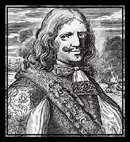 Henry
Morgan (1635-1688). Born in Wales, Henry Morgan
had a distinguished career as an Admiral in the English Royal Navy
before turning to piracy. He went to Jamaica in 1658, where he took
part in Oliver Cromwell's plan (known as the Western Design) to
invade Hispaniola Island, which comprised both the Dominican
Republic and Haiti. The governor of Jamaica, Sir Thomas Modyford,
sent Morgan on Cuban expeditions to capture Spanish prisoners
through 1667-1669, which included Puerto Principe. Morgan also took
Portobelo in Panama, although he later accepted a large ransom from
the Panamanian governor to withdraw. However, Morgan returned in
1671 with land and sea forces. After taking more than one hundred
thousand pounds in booty, Morgan and his men burned down the city
and all of its residents. Because of his barbaric actions, Morgan
was remanded to England the next year. He was knighted before
returning to Jamaica in 1675, where he took the post of Lieutenant
Governor. He was later dismissed from the Jamaican Council by
Governor Thomas Lynch. Morgan's health began to deteriorate in 1681,
when he was diagnosed with either dropsy or tuberculosis. He died on
August 25, 1688. Some historians believe his death may have been
caused by liver failure due to heavy drinking throughout his
lifetime. He was buried in Palisadoes Cemetery, which later sank
beneath the sea following an earthquake in 1692.
Henry
Morgan (1635-1688). Born in Wales, Henry Morgan
had a distinguished career as an Admiral in the English Royal Navy
before turning to piracy. He went to Jamaica in 1658, where he took
part in Oliver Cromwell's plan (known as the Western Design) to
invade Hispaniola Island, which comprised both the Dominican
Republic and Haiti. The governor of Jamaica, Sir Thomas Modyford,
sent Morgan on Cuban expeditions to capture Spanish prisoners
through 1667-1669, which included Puerto Principe. Morgan also took
Portobelo in Panama, although he later accepted a large ransom from
the Panamanian governor to withdraw. However, Morgan returned in
1671 with land and sea forces. After taking more than one hundred
thousand pounds in booty, Morgan and his men burned down the city
and all of its residents. Because of his barbaric actions, Morgan
was remanded to England the next year. He was knighted before
returning to Jamaica in 1675, where he took the post of Lieutenant
Governor. He was later dismissed from the Jamaican Council by
Governor Thomas Lynch. Morgan's health began to deteriorate in 1681,
when he was diagnosed with either dropsy or tuberculosis. He died on
August 25, 1688. Some historians believe his death may have been
caused by liver failure due to heavy drinking throughout his
lifetime. He was buried in Palisadoes Cemetery, which later sank
beneath the sea following an earthquake in 1692. -
 Grace
O'Malley (aka Granuaile or Sea Queen of Connaught;
1530-1603). Born near Clew Bay in County Mayo, Grace was the
daughter of sea captain Eoghan Dubhdara Ó Máille (Owen O'Malley).
According to legend, Grace always wanted to be a sailor. When her
father refused to take her on a sea journey aboard one of his ships,
she cut her hair and dressed in male clothes. Later, Grace would
accompany her father on many of his trading missions. In 1546, Grace
married Dónal O'Flaherty and bore him three children: Owen, Margaret
and Murrough. After Dónal was killed in battle, his men were so
loyal to Grace that they followed her back to Clare Island. Grace
married Irish chieftain Risdeárd an Iarainn Bourke ("Iron Richard")
in 1566. Their only son, Theobald, was later knighted by Charles I
as Sir Theobald Bourke, Viscount Mayo. As she grew older and more
experienced, Grace acquired her own fleet of ships. She also managed
to amass several islands and castles on the west coast of Ireland.
Grace recruited men from Ireland and Scotland for her crews, who
aided her in attacking ships as far away as Waterford along with
shoreline fortresses and castles. At one point, she also demanded
money or treasure from ships hoping to gain safe passage through the
waters near her estates. Resistance was often met with violent or
fatal skirmishes. When her sons Murrough and Theobald were taken
captive by Sir Richard Bingham (Governor of Connacht) in 1593, Grace
went to England to petition Queen Elizabeth I for their release.
After debating over a list of demands, Elizabeth agreed to release
Murrough and Theobald. Grace continued her support of Irish
rebellions through the Nine Years War (1594-1603). She reportedly
retired to Rockfleet Castle in County Mayo, where she died in 1603.
Grace
O'Malley (aka Granuaile or Sea Queen of Connaught;
1530-1603). Born near Clew Bay in County Mayo, Grace was the
daughter of sea captain Eoghan Dubhdara Ó Máille (Owen O'Malley).
According to legend, Grace always wanted to be a sailor. When her
father refused to take her on a sea journey aboard one of his ships,
she cut her hair and dressed in male clothes. Later, Grace would
accompany her father on many of his trading missions. In 1546, Grace
married Dónal O'Flaherty and bore him three children: Owen, Margaret
and Murrough. After Dónal was killed in battle, his men were so
loyal to Grace that they followed her back to Clare Island. Grace
married Irish chieftain Risdeárd an Iarainn Bourke ("Iron Richard")
in 1566. Their only son, Theobald, was later knighted by Charles I
as Sir Theobald Bourke, Viscount Mayo. As she grew older and more
experienced, Grace acquired her own fleet of ships. She also managed
to amass several islands and castles on the west coast of Ireland.
Grace recruited men from Ireland and Scotland for her crews, who
aided her in attacking ships as far away as Waterford along with
shoreline fortresses and castles. At one point, she also demanded
money or treasure from ships hoping to gain safe passage through the
waters near her estates. Resistance was often met with violent or
fatal skirmishes. When her sons Murrough and Theobald were taken
captive by Sir Richard Bingham (Governor of Connacht) in 1593, Grace
went to England to petition Queen Elizabeth I for their release.
After debating over a list of demands, Elizabeth agreed to release
Murrough and Theobald. Grace continued her support of Irish
rebellions through the Nine Years War (1594-1603). She reportedly
retired to Rockfleet Castle in County Mayo, where she died in 1603. -
John Rackham (aka Calico Jack; 1682-1720). John Rackham was born in Cuba to English parents. Little is known about his early life, although his name appears in records from 1718, when he was a quartermaster on Captain Charles Vane's sloop Ranger. Later that same year, John and the rest of the crew voted out Vane, whereupon John became the new captain. At first, John raided small vessels near shore. In 1719, he and his crew sailed to the Bahamas (Nassau), where pirates were known to be given clemency by Governor Woodes Rogers. That same year, John captured the merchant ship Kingston. However, the vessel was stolen back by bounty hunters hired by Port Royal merchants. John and his crew returned to Nassau to plead for pardons from Governor Rogers, which he granted. In 1720, John seized several fishing vessels near Jamaica, where he also terrorized locals along the northern coastline. Not long afterward, John's ship was attacked and captured by an armed sloop led by pirate hunter Jonathan Barnet. Once back in Jamaica, John was sentenced and hung on November 18, 1720 in Port Royal. John's two female crew members Anne Bonny and Mary Read – who were both thought to be his lovers – were spared.
-
Mary Read (1692-1720). Mary was born outside of wedlock to the widow of a sea captain. In order to receive financial support from a paternal grandmother, Mary dressed as a boy to convince everyone she was her older brother Mark, who had died. Still dressing as a boy, Mary found work on a ship. She later joined the military, where she proved her skill in battle during the Nine Years War before marrying a Flemish soldier. The couple acquired an inn named the Three Horseshoes near Breda Castle in The Netherlands. However, after the early death of her husband, Mary resumed dressing like a man and joined military service in Holland. Following a short stint in peacetime, she left for the West Indies aboard a ship which was ultimately captured by pirates, who forced her to join them. In 1720, still dressed in male clothes, she became part of the crew manned by John "Calico Jack" Rackham and his lover, Anne Bonny. When Rackham's ship was captured by pirate hunter Jonathan Barnet, Mary allegedly shot and killed one of the crew members when he refused to fight off Barnet. Rackham, Bonny and Mary were brought to trial in Jamaica, where they were sentenced to hang. Mary was granted a slight reprieve after claiming she was pregnant. It is thought she died in prison in April 1721, after suffering childbirth fever.
-
Bartholomew Roberts (aka Great Pirate Roberts or Black Bart; 1682-1722). Not to be confused with Wild West outlaw Black Bart, John (Black Bart) Roberts was born in Wales. Some historians believe he went to sea as early as 1695. However, records of his maritime existence did not surface until 1718, when he was crewmate aboard a sloop in Barbados. By 1719, he was a crew member under Captain Howell Davis on the Royal James. After Davis was ambushed and killed, Roberts was elected captain. He raided ships off the Americas and West Africa between 1719 and 1722, becoming one of the most successful pirates with 470 vessels taken during the course of his career. He was also known to dress in the finest clothes and jewelry. He detested drunkenness at sea. Unlike most pirates of his day, he preferred drinking tea rather than the prerequisite rum. His crew was said to be unfailingly loyal, admiring his bravery and courage. Roberts was killed on Cape Lopez in February 1722 during a battle with HMS Swallow, which was captained by British Admiral of the Fleet Sir Chaloner Ogle. Ahead of the battle, Roberts outfitted himself in the finest of clothes. Captain Charles Johnson wrote about Roberts in his book "A General History of the Robberies & Murders of the Most Notorious Pyrates" (1724): "Roberts himself made a gallant figure, at the time of the engagement, being dressed in a rich crimson damask waistcoat and breeches, a red feather in his hat, a gold chain round his neck, with a diamond cross hanging to it, a sword in his hand, and two pairs of pistols slung over his shoulders." Roberts was struck in the throat by grapeshot during the battle with HMS Swallow in 1722. Before his corpse could be taken by Ogle, crew members weighed down and wrapped his body in a ship's sail and threw it overboard. He was never found.
-
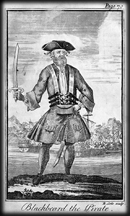 Edward
Teach (aka Blackbeard; 1680-1718). Perhaps the
most famous of all pirates, Edward "Blackbeard" Teach was reportedly
born in Bristol, England in 1680. Little is known about his early
life. His surname of Teach is also often disputed, with some
historians claiming it was more likely a form of Tack, Thache,
Thatch, Thack or Theach. Whatever the case, Edward would eventually
become renowned for his rather flamboyant appearance.
Edward
Teach (aka Blackbeard; 1680-1718). Perhaps the
most famous of all pirates, Edward "Blackbeard" Teach was reportedly
born in Bristol, England in 1680. Little is known about his early
life. His surname of Teach is also often disputed, with some
historians claiming it was more likely a form of Tack, Thache,
Thatch, Thack or Theach. Whatever the case, Edward would eventually
become renowned for his rather flamboyant appearance.
Captain Charles Johnson, author of the book "A General History of the Robberies & Murders of the Most Notorious Pyrates" (1724), described Teach thusly:
So our heroe, Captain Teach, assumed the cognomen of Blackbeard, from that large quantity of hair, which, like a frightful meteor, covered his whole face, and frightened America more than any Comet that has appeared there a long time. This beard was black, which he suffered to grow of an extravagant length; as to breadth, it came up to his eyes; he was accustomed to twist it with ribbons, in small tails, after the manner of our Ramilies Wiggs, and turn them about his ears. He wears a sling over his shoulders, with three brace of pistols, hanging in holsters like bandoliers; and stuck lighted matches under his hat. Such a figure that imagination cannot form an idea of a fury from hell to look more frightful.
Reportedly, Blackbeard worked as a sailor during Queen Anne's War (1702–1713) before arriving in the Bahamas in 1716. He joined the crew of Captain Benjamin Hornigold, who later gave him command of a plundered vessel he renamed Queen Anne's Revenge. He later acquired more ships, the most notable of which was the 80-ton trading sloop Adventure. He pillaged along the Virginia and Carolina coasts, as well as in the Caribbean Sea. For a brief time, Blackbeard partnered with Stede Bonnet on runs along the South Carolina coast. At the height of his career, Blackbeard commanded nearly seven hundred men.
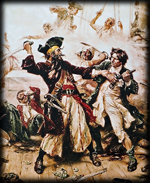 Blackbeard established his
base in Ocracoke Inlet, North Carolina sometime in 1718, shortly
after running Queen Anne's Revenge aground. A British naval force
led by Lieutenant Robert Maynard attacked the inlet, where
Blackbeard died on November 22, 1718 after suffering multiple sword
and gunshot wounds. Lieutenant Maynard ordered Blackbeard’s head to
be cut off, after which his body was thrown overboard. The head was
displayed on the bowsprit of his ship.
Blackbeard established his
base in Ocracoke Inlet, North Carolina sometime in 1718, shortly
after running Queen Anne's Revenge aground. A British naval force
led by Lieutenant Robert Maynard attacked the inlet, where
Blackbeard died on November 22, 1718 after suffering multiple sword
and gunshot wounds. Lieutenant Maynard ordered Blackbeard’s head to
be cut off, after which his body was thrown overboard. The head was
displayed on the bowsprit of his ship.
Despite his rather fearsome and notorious reputation, Blackbeard was never known to murder anyone. Some historians also claim he had more than fourteen wives during his lifetime.

